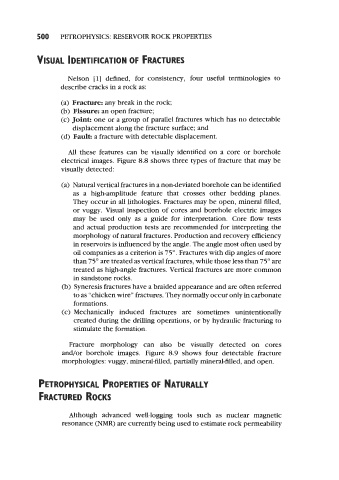Page 533 - Petrophysics
P. 533
500 PETROPHYSICS: RESERVOIR ROCK PROPERTIES
VISUAL IDENTIFICATION FRACTURES
OF
Nelson [l] defined, for consistency, four useful terminologies to
describe cracks in a rock as:
(a) Fracture: any break in the rock;
(b) Fissure: an open fracture;
(c) Joint: one or a group of parallel fractures which has no detectable
displacement along the fracture surface; and
(d) Fault: a fracture with detectable displacement.
All these features can be visually identified on a core or borehole
electrical images. Figure 8.8 shows three types of fracture that may be
visually detected:
(a) Natural vertical fractures in a nondeviated borehole can be identified
as a high-amplitude feature that crosses other bedding planes.
They occur in all lithologies. Fractures may be open, mineral filled,
or vuggy. Visual inspection of cores and borehole electric images
may be used only as a guide for interpretation. Core flow tests
and actual production tests are recommended for interpreting the
morphology of natural fractures. Production and recovery efficiency
in reservoirs is influenced by the angle. The angle most often used by
oil companies as a criterion is 75". Fractures with dip angles of more
than 75" are treated as vertical fractures, while those less than 75" are
treated as high-angle fractures. Vertical fractures are more common
in sandstone rocks.
(b) Syneresis fractures have a braided appearance and are often referred
to as "chicken wire" fractures. They normally occur only in carbonate
formations.
(c) Mechanically induced fractures are sometimes unintentionally
created during the drilling operations, or by hydraulic fracturing to
stimulate the formation.
Fracture morphology can also be visually detected on cores
and/or borehole images. Figure 8.9 shows four detectable fracture
morphologies: vuggy, mineral-lilled, partially mineral-filled, and open.
PETROPHYSICAL PROPERTIES OF NATURALLY
FRACTURED ROCKS
Although advanced well-logging tools such as nuclear magnetic
resonance (NMR) are currently being used to estimate rock permeability

